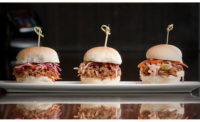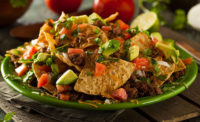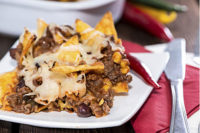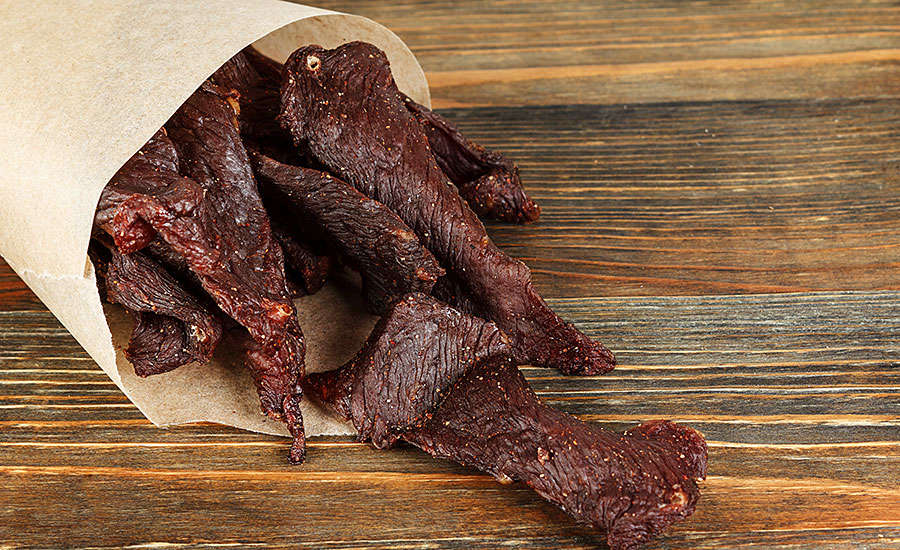Formulation Strategies
Use of meats in innovative snacks, sides and appetizers
Tasty bites: Unique sides and appetizers, as well as high-protein snacks appeal to consumers who want flavor in small (and healthy) doses.






Changing consumer dining preferences and attitudes along with shifting demographics are boosting the potential for larger and more diverse holiday sales for meat and poultry merchandisers.
Paleo, Whole 30 and low inflammation diets all share one thing in common: high protein. As more (younger) consumers look for protein snacks to fill them up, they also are finding innovative, flavorful options on restaurant menus besides the grocery aisles.
“Protein is definitely in the spotlight these days, being emphasized in a lot of popular diets such as the Whole 30 or gluten-free eating,” says Jackie Rodriguez, senior project manager, Datassential, a Chicago-based market research firm. “In snacking, in particular, consumers say they are looking for high-protein choices, and we’re seeing innovation around that demand with things like salmon jerky and trail mixes featuring beef or turkey jerky.”
Those trends bode well for future protein growth, whatever the format. And while plant-based proteins are encroaching on areas where meat has traditionally held its ground, popular meats are being used in innovative snacks, sides and appetizers at retail and restaurants.
“America’s three core proteins [beef, chicken and pork] are being used more as a carrier for flavor than really positioned as ‘meat,’ and, finally, non-traditional proteins like game meat are popping up on mainstream menus,” says Locke Hilderbrand, executive vice president and chief insights officer, CultureWaves, a consumer qualitative insights company, based in Springfield, Mo. “This means there is plenty of opportunity for those who are willing to innovate and go beyond the norm.”
Snackifying meat
It’s hard to find something more popular at grocery than the snack aisle. In fact, 94 percent of U.S. consumers snack at least once a day, with 50 percent snacking two to three times daily, according to Chicago-based Mintel’s Snacking Motivations and Attitudes — US, April 2015.
Last year, the blurring of snacks with meal times led to snack-targeted products in processed meat, fish and meat substitutes, increasing 11 percent from 2014 to 2016, noted Mintel’s Meat, Poultry & Fish Global Annual Review. The main driver? The need for convenience, ease and on-the-go attributes. In the U.S., 53 percent of consumers buy meat-based snacks, compared with 95 percent of Chinese shoppers.
“Consumers today say that anything can be a snack, and that means they are often reaching for protein-based items that previously may have been considered traditional entrees or mains,” Rodriguez says.
Younger shoppers also want snacks that improve their energy and help them manage their weight, reports Mintel. They particularly want high-protein snacks, which were 13 percent of new global product launches in 2016.
Protein-heavy Paleo Diet followers have many choices in the $2.8 billion meat snack category, such as Krave and EPIC meat snack launches and Jack Link’s, Slim Jim, Oberto and Hillshire Farm’s jerky products, to name a few. Jerky grew 3.5 percent in sales for the year ended Feb. 25, 2017, according to Nielsen’s Where’s the Beef? Check the Snack Aisle report.
The $33 billion individual snacking category offers single-serve grab-and-go products for busy consumers as snacks or meals, notes New York-based Nielsen’s Individual Snacking Categories on the Rise in the U.S. It’s hard to overstate the importance of jerky as the second-fastest growing individual snacking category, coming in at $547 million sales growth with a 5 percent increase from 2013 to 2016.
Protein-rich snack kits, minimally processed and artisan products are also reaching on-the-go consumers, Mintel reports.
Moreover, based-on-a-true-story products, which share producers’ back stories, can connect with consumers who want an emotional connection with companies, to see an ethical image and hear about animal welfare details, reports the research firm.
While consumers prefer healthy choices, they are also willing to buy less healthy — but convenient — options at convenience channels. Nielsen noted 44.2 percent of consumers are willing to pay premium prices at convenience stores. Imagine if healthier snacking options are available to them, especially as 33 percent reported wanting to buy fresh food at convenience channels.
Meat-based snacks also come with a higher price tag of $7.42 per trip or $25.81 per American household every year, Nielsen reports, which is almost twice as much as chips or popcorn prices.
Seafood and pork snacks have shown inconsistent growth, according to Nielsen’s Where’s the Beef? insights. In 2013 and 2014, the nearly $2 million seafood snack category grew almost 200 percent a year before losing ground in 2015 and 2016. Pork snacks also hit their high point in 2014 with 6.5 percent sales growth, compared with almost 1 percent for the most recent 12-month period (as of March 2017).
How does chicken fit into this trend? While almost three quarters of 2017 poultry launches included claims about convenient packaging or being microwavable (up 75 percent from 2014), not many Americans are snacking on poultry at home, reports Mintel’s Poultry — US, November 2017 report. Only 9 percent eat poultry for breakfast at home and 15 percent eat it as a snack.
Poultry performs better in foodservice as a snack, such as nuggets or wings as an indulgent treat. Also, in the last two years poultry, such as fried chicken, has increased on brunch and breakfast menus, Mintel reports.
More consumers in a Canadean GlobalData 2016 Q3 survey say they are snacking between breakfast and lunch, as well. “Thirty-eight percent of American consumers said they snack between breakfast and lunch,” says Thomas Vierhile, innovation insights director of GlobalData Consumer, formerly known as Canadean, based in New York. “We asked the same question in our 2014 survey and that figure was just 29 percent, so there has been a huge shift toward more snacking in the morning in just a couple of years.”
Jack Link’s has launched a line of A.M. meat snack/meal products that are shelf stable, he says.
Just as plant-based proteins are gaining momentum at foodservice, they are also entering the grocery store as snacks — including plant-based jerky and meatless jerky snacks. “The snack aisle is becoming both an innovation hotbed for plant-based proteins and a place to show consumers the amount of options they have when it comes to plant-based proteins,” says Hilderbrand.
Ethnic flavors are also influencing snacks as protein-dense products with unique global flavors being pushed to the forefront, Hilderbrand says, “giving consumers access to unique flavor combinations and experiences in a snack and small bite format.”
Experimenting with frozen flavors
Ethnic-inspired flavor profiles continue to gain traction in frozen appetizers, including Sweet Asian Chili-flavored Pierre Daredevil Boneless Wyngz and Day-Lee Pride Umami Gyoza Dumplings in Chicken and Shitake, Vierhile says.
“The latter is one of the first appetizer products I have seen that references the ‘umami’ flavor,’” says Vierhile.
Handheld seems to be popular in frozen appetizers as companies continue to experiment with the format. “I like how the DiGiorno Pizza Buns product uses a different physical format — a round bun — to market the pizza flavor profile in a novel way that may be more hygienic and less messy than eating a regular slice of pizza,” Vierhile says.
Another bread app, Brazi Bites Brazilian Cheese Bread, combines the handheld format with ethnic flavors and can be used as a small sandwich bun. At the Natural Products Expo East trade show, its trade booth boasted of 4,554 percent growth in three years, Vierhile says.
Good old mac and cheese continues to be popular, and companies are combining this dish with handheld snacks or appetizers. “One of the more unusual launches here is Gorton’s Seafood Appetizers in flavors like Mac & Cheese Shrimp Bites,” says Vierhile.
Brands still matter, and Frito-Lay’s Mac n’ Cheetos Breaded Macaroni and Cheese Snacks leverage the drawing power of its Cheetos snack brand with mac and cheese flavor.
“Mistica Ranch Meats Chicken Bites made with Cheez-It Crackers takes a similar route of utilizing some marketing help from Kellogg’s Cheez-It brand,” Vierhile says.
Innovation in plant-based protein is also picking up in frozen appetizers. Hanover Blended Proteins Steam-in-Bag products, for example, offer 25 grams of protein per serving and could serve as a main dish on some occasions, Vierhile says.
Menuing of meats
Also popular at restaurants are handheld appetizers such as sliders and empanadas which can feature ground or shredded beef, pork or chicken, Rodriguez says. “Appetizers/shareables are well suited to proteins that can be used in varying amounts and with different flavor profiles,” she says.
Proteins such as chicken wings will always have a spot on the menu, “but we are seeing increased menuing of meats,” Rodriguez says. “Beef, for example, has increased by 15 percent on appetizer menus over the past 10 years, while pork and bacon also are up.”
When consumers are surveyed on which protein-based apps and small plates they are most likely to order at restaurants, they report picking boneless barbecue wings (41 percent); chicken strips, nuggets or tenders (41 percent); and breaded shrimp (39 percent), says Lizzy Freier, managing editor, menu analysis for Chicago-based Technomic, according to Technomic’s 2017 Starters, Small Plates & Sides Consumer Trend Report, powered by Ignite.
“After soup and salad, breaded protein and nonbreaded protein are the next two leading appetizers at Top 500 FSRs [full-service restaurants], with top claims being calamari, chicken strips and breaded shrimp for the former and shrimp, fish and oysters for the latter,” Freier says.
Breaded proteins, in fact, grew 8 percent in operator incidences in the past two years at Top 500 LSRs (limited service chains), with chicken strips garnering the top and fastest-growing mentions.
“Some trending ingredients in apps include pork [up 30 percent] and steak [up 29 percent],” as well, Freier says.
As consumers look for new cuts and cooking methods for beef, chicken and pork, non-traditional meats are emerging across mainstream menus, Hilderbrand says.
“Small-bite game meat is becoming a way to gauge consumer interest without them investing in a full meal or large price tag,” Hilderbrand says.
Bar and beverage menus, in particular, are being reimagined in innovative ways, he says.
“The bar menu is becoming a permissive indulgence playground, as well as an opportunity to showcase unique appetizers,” Hilderbrand says. “This is manifesting in the form of plant-based protein and non-traditional meat appetizers ranging from elk sliders to tempeh lettuce wraps.”
Rethinking sides
Traditionally, proteins haven’t played a big role in side dishes, save for a flavor boost or garnish like crumbled bacon, says Rodriguez.
But protein is finding an increased role in breakfast sides and as mini-meals at dinner.
“Protein sides are not only one of the leading breakfast sides at Top 500 LSRs, but also the fastest-growing at 35 percent,” says Freier. “Protein sides follow potato in the leading breakfast sides at Top 500 FSRs.”
Top 500 lunch and dinner menus are offering 4.9 percent more protein sides, as well, she says.
“Mentions of protein sides also grew 2 percent in lunch and dinner sides at Top 500 FSRs, by operator incidence,” Freier says.
The rise of plant-based entrees is creating an opportunity and growth for protein-rich sides, she says.
“Indeed, 35 percent of consumers call for restaurants to offer more meat-focused sides, and lunch/dinner menus reflect a 40 percent increase in the number of sides on Top 500 menus featuring pork in the last year,” Freier says.
Protein sides can include meat-only options including skewers or meatballs, or protein and vegetable dishes such as brussels sprouts and prosciutto.
“While many of these sides will utilize classic proteins, operators may use sides as an affordable, low-risk way for consumers to try different proteins,” Freier says. “For instance, emerging chain Little Greek Fresh Grill offers lamb skewer sides.”
These dishes can be ordered as bundled meals so consumers can try a variety of flavors, she notes.
“Popular proteins will become more influenced by the growing veggie trend, with new offerings marrying proteins and veggies — and less common meats are slated to emerge on chain menus, such as duck, lamb and elk meat in items like sliders and meatballs,” Freier says.
In addition, new preparations will drive interest in more traditional protein options such as Korean fried chicken or pork wings, replacing common Buffalo wings, says Freier, especially with the current rising cost of chicken wings.
“We also have seen some chain restaurants introducing mini versions of protein-based items, such as Taco Bell’s mini steak quesadillas and Church’s Chicken’s Chicken and Biscuit Bites, which scored highly in our consumer rating tool,” Rodriguez says.
In fact, 62 percent of consumers agreed that “anything can be a snack,” reports Datassential’s MenuTrends Keynote Report. The top non-traditional snacks were a sandwich or wrap (20 percent ate this outside of a regular meal), 11 percent had pizza, 10 percent had breakfast cereal, 9 percent had a burger or slider and 7 percent had chicken wings/nuggets.
“The rise in ethnic flavors across snacking is pushing protein-dense snacks with unique global flavors to the forefront, giving consumers access to unique flavor combinations and experiences in a snack and small bite format,” Hilderbrand says.
So while traditional proteins have emerging competition with plant-based proteins in snacks, sides and appetizers, plenty of evidence suggests they will hold their own by offering ethnic, unique and healthy bites or mini-meals.
“Traditional proteins are being positioned as familiar with a twist, as sauces, condiments and other ingredients take center stage with the protein being the flavor carrier,” Hilderbrand says. NP
Looking for a reprint of this article?
From high-res PDFs to custom plaques, order your copy today!










